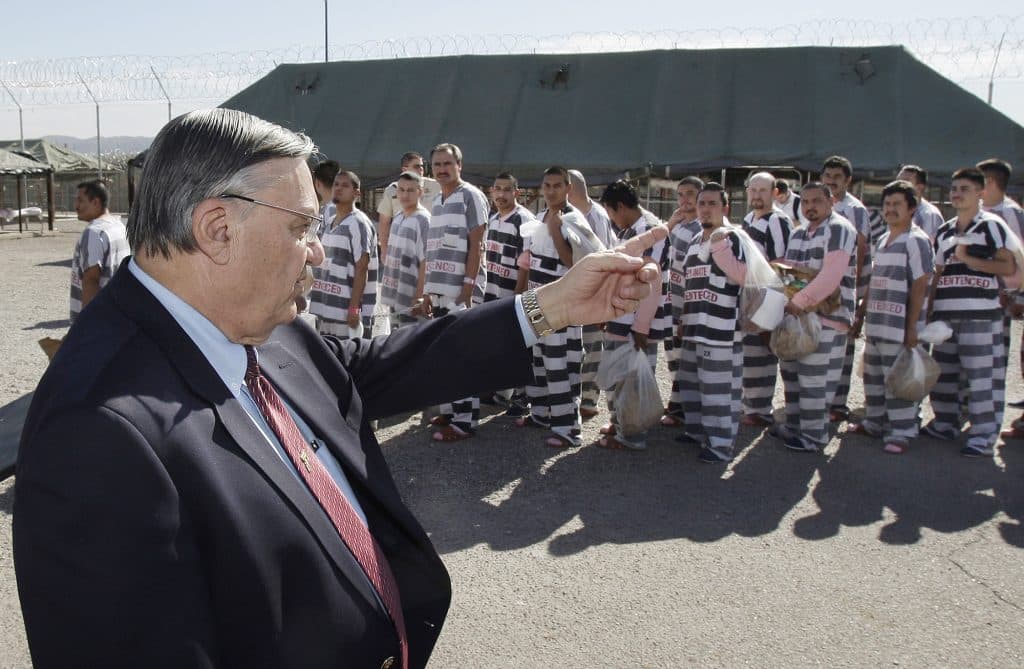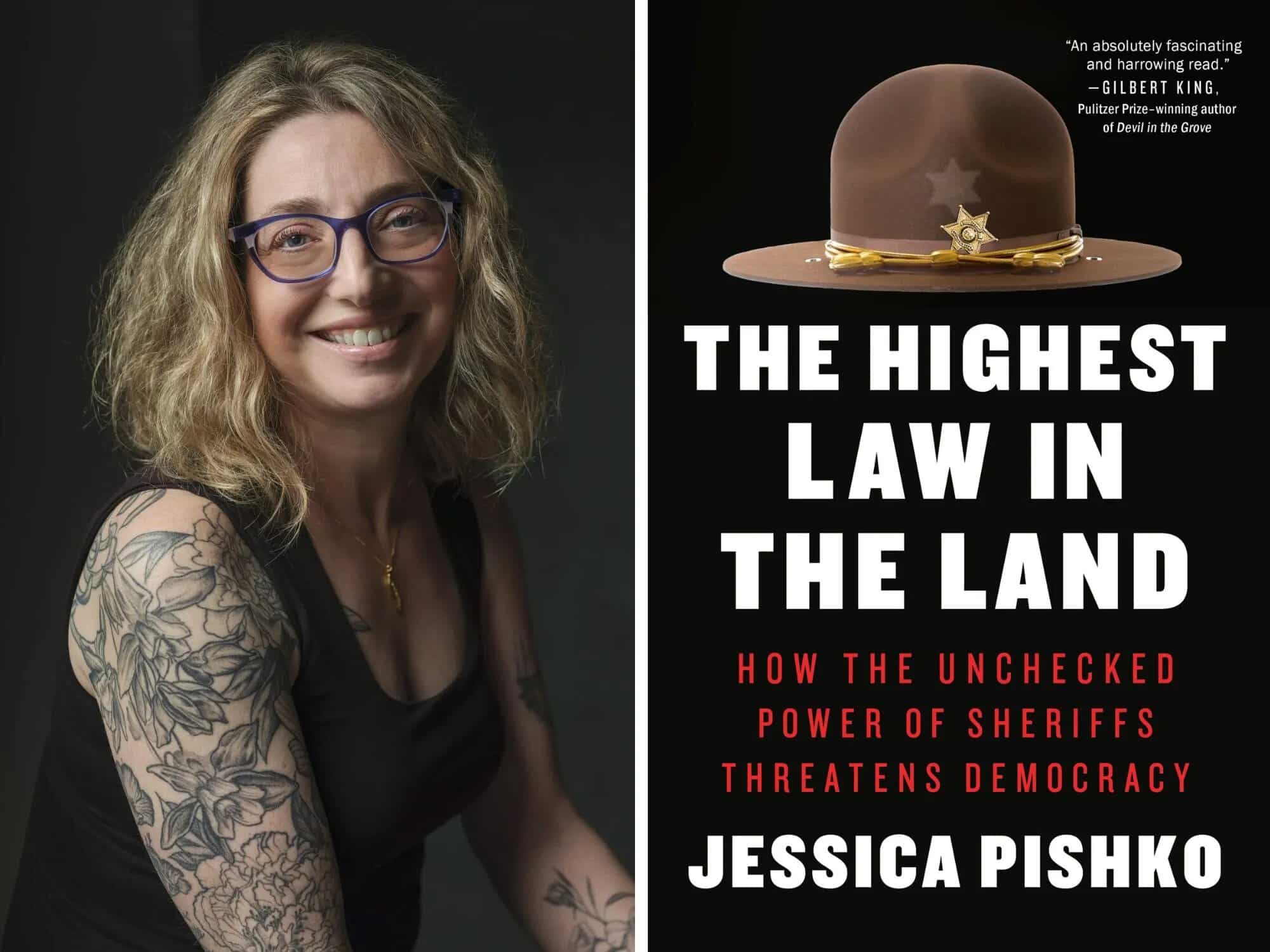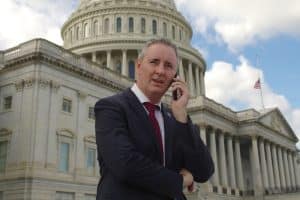Jessica Pishko is a journalist and lawyer with a JD from Harvard Law School and an MFA from Columbia University. She is the author of The Highest Law in the Land: How the Unchecked Power of Sheriffs Threatens Democracy. She has been reporting on the criminal legal system for a decade, with a focus on the political power of sheriffs since 2016.
In addition to her newsletter Posse Comitatus, her writings have been featured in The New York Times, Politico, Rolling Stone, The Atlantic, The Appeal, Slate, and Democracy Docket. She has been awarded journalism fellowships from the Pulitzer Center and Type Investigations and was a 2022 New America Fellow. A longtime Texas resident, she currently lives with her family in North Carolina.
She joins us today to talk about the ICE 287(g) program partnering with a growing number of sheriffs departments across the country, including right here in Bucks County, as well as how this development fits within the history of Sheriffs in the United States.
Listen on Apple, Spotify, Podbean and iheart
TRANSCRIPT
In Bucks County, our Sheriff Fred Harran, he’s partnering with ICE after unilaterally signing up for its 287(g) Task Force model program, a tool President Trump has turned to and in many ways revitalized in order to carry out his mass deportation program. Can you explain the history of 287(g), which actually predates Trump?
So the 287(g) program, which is just named after the provision in immigration law that permits it, basically, it’s a program, an optional program that allows local law enforcement agencies to partner or contract with ICE to do certain kinds of immigration enforcement. There are three basic types of 287(g) agreements. There’s the jail enforcement model 287(g) agreement. There’s a second 287(g) agreement a warrant service officer agreement. Now, both of those generally operate inside the jail. They have slightly different names because they use different mechanisms because of the issue of detainers, which we can also talk about. But because of the way ICE operates, they created two different versions that essentially operate inside of jails.
And then the third version of the 287(g) agreement is called the Task Force Model. And this was a model that essentially is what Joe Arpaio used. I just say it shorthand. It’s the Joe Arpaio model, right? It has generally been used by law enforcement agencies that are really invested in going out and arresting people who might be potentially deportable immigrants.
READ: Sheriff Fred Harran Enlists Bucks County in Trump’s Nationwide Immigration Crackdown
It is the version that lets, again, police to go into the street and in the daily course of their business, conduct traffic stops and arrest people that they see that they think might be potentially deportable. Because that one operates out in public and has very few limitations, this is the version that has been the most controversial is this task force version, which is what I understand what the sheriff signed up for.
Yes. And can you explain a little bit for our listeners who Sheriff Arpaio is or was? He’s not a sheriff there anymore, but it was it either self declared toughest sheriff in America.
I think he claimed the mantle of toughest sheriff in America, although he may or may not have like vague competition on that one. So Joe Arpaio was a sheriff for a very long time, like about two decades in the 90s and 2000s, and also when Barack Obama was president. And Joe Arpaio essentially became the poster child in Arizona for anti-immigration enforcement. He was very invested in arresting people who might be deportable immigrants. He used the 287(g) task force to pull over cars, largely of Latino drivers. So he was basically just engaging in racial profiling. He also built what some people might remember the infamous tent city jail, which he used just to house people who were immigrants awaiting deportation or were on their way to ICE detention. So, he really built his reputation on being anti-immigrant. This was also during a time when Arizona itself, to put in some context, Arizona itself was going through a lot of anti-immigrant animus and the state legislature had passed a variety of laws that were intended to give local law enforcement that opportunity, in their words, to basically arrest more immigrants. This is all just boiling down. And these are a variety of anti-immigrant laws that we are now seeing again. They’re very similar to some of the laws passed in Texas and Florida that are state laws intending to criminalize immigrants.
And that is just to make it easier for law enforcement to arrest and detain them.
And in 2011, the Department of Justice actually investigated Arpaio’s operations in Arizona and concluded that, you know, that it was just riddled with constitutional violations and, like you said, racial profiling. And this actually led President Obama to suspend the program.

That’s right. So basically, because Joe Arpaio had abused it so mightily, this 287(g) Task Force Model was in essence suspended, but never really canceled. It was a bit of a weird interim, which I think made it easier to revive. And I will say in fairness, Trump did not revive it during his first term in 2016. He did not revive this Task Force model. It was, and it has been, and is generally viewed with some concern, largely because Joe Arpaio was not only charged by the Department of Justice, he would have been criminally punished had Trump not pardoned him. But he also cost his county, which is Maricopa County where Phoenix is located, he cost the county a great deal of money. He cost a great deal of money in terms of settling lawsuits. And then there is still, even now, pending an ongoing consent decree for the Maricopa County Sheriff’s Office because of our privacy abuses.
Those things that led to, again, a great deal of expenditure of taxpayer money in Phoenix and a lot of oversight of the sheriff’s office made the task force model not desirable because people were concerned about having the same thing happen. I will say that one of the things that happened this time Trump became president, you know, is Tom Homan became what they are calling the “Border Czar” because it is an unconfirmed appointment.
It was something that Donald Trump just appointed Tom Homan to. Tom Homan had been running ICE under Trump’s first term, but he actually could not get appointed. Congress would not confirm his position because he has too many bad things in his past and they didn’t like his background. So just to say, the reason why Tom Homan is in this job to begin with is because he could not get confirmed by Congress. He was too controversial.
READ: The Dangerous Depravity of Trump ‘Border Czar’ Tom Homan
But needless to say, Tom Homan is a big fan of these task force agreements. He has spent the last four years building relationships with law enforcement, especially sheriffs. When he was recently in Arizona, there was a special sort of state legislature joint session where Tom Homan talked about, you know, the great urgency of vast deportation and gave Joe Arpaio a big hug and, you know, sort of addressed him as like, the best sheriff in terms of immigration enforcement. So I do think since Arpaio’s pardon, we’re seeing this like wholesale flip to kind of rewrite what Arpaio did, which is again, not an unfamiliar tactic in this administration, but I do think that that led to these task force agreements becoming, and I will say in fairness, they are becoming not just something you can do, but they’re actually becoming a little bit mandatory. So there is, has been a lot of pressure from Tom Homan and the DHS, the Trump administration and organizations like the National Sheriffs Association and Stephen Miller, of course, who have basically emailed law enforcement agencies, especially sheriffs’ offices and told them that if they do not join a 287(g) agreement, task force model preferred, like they were told you ought to join the task force model or some287(g) agreement, or you’re going to get put on basically Stephen Miller’s naughty list of sanctuary jurisdictions. So there is this like huge amount, like I just want to say there’s a huge amount of pressure, like not just to say, oh, we’re reviving this old agreement. You can join if you want. It’s actually being presented to a lot of law enforcement by law enforcement to say you must join this agreement, we want you to join it, and if you don’t join it, we can’t guarantee that either the Department of Justice or someone else won’t sue you. And some of these ICE tactics we have seen ramping up in recent days in places like Los Angeles, Phoenix, they’ve been, I think, appearing outside of courthouses and doing a lot of ICE activity to arrest people. And part of that is intended to be a bit of a threat for people, I think, to want their local law enforcement agencies to sign up for these task force agreements or else they’re going to get ICE agents. I think it’s becoming a bit of like an implied threat that places need to do this.
I just want to note too that the Associated Press just reported that taxpayers in Arizona are going to be on the hook for up to $352 million by 2026 due to the lawsuits as a result of the racial profiling and other constitutional violations that Arpaio undertook, which is a staggering amount of money.
It is. I mean, no question, like he cost people there a lot of money. And for a long time, this was a huge deterrent to doing these.
I mean, and task force agreements have happened in other places, not as notable as Phoenix, but I will say that the places who have engaged in these task force agreements have all generally faced lawsuits, you know, a variety of investigations for racial profiling. Like this is a model that has generally been used by the most ill-intentioned law enforcement agencies who seem to be engaging in racial profiling.
I live in North Carolina. We have a few counties here who had before signed up for task force agreements. They are more rural. They do not have as many people, but it was shown that the sheriffs who signed up for these task force agreements at the time were intentionally saying, you know, derogatory racist language, intentionally telling their people to go target immigrants with form of racial profiling rights. They’re targeting people with brown skin, don’t speak English, particularly well. So this is just a form of targeting. They will argue otherwise, but I have trouble seeing any good argument that it’s not.
So who’s responsible for entering these partnerships with ICE? Because there’s a big controversy right now here locally in Bucks County. The ACLU of Pennsylvania is preparing a lawsuit arguing that here the sheriff lacks the authority, and they cite the Pennsylvania Constitution and the Pennsylvania Intergovernmental Cooperation Act, which if you read it, seems to mandate that only the Bucks County commissioners – the county’s only legitimate governing body – can legally enter an agreement with ICE. Now, Sheriff Harran has gone on a right-wing podcast called the ACLU lunatics and has since reached out to America First Legal, who will be co-counsel for them. Can you explain to listeners how this works and maybe talk a little bit about America First Legal and their founder Stephen Miller?
Sure. When I heard America First Legal, I thought, of course. But just to return to the issues of who makes these decisions. So one of the things about sheriffs and indeed all local law enforcement agencies is that they are governed mostly by state law.
And so sheriffs and indeed police, cities, counties, they’re creations of the state. And so in Pennsylvania, as an example, sheriffs and law enforcement agencies have to abide by state law. And different states have wildly different laws when it comes to what extent their local law enforcement can or should cooperate with immigration, right? So some states like Washington state, California, are what have kind of been described as sanctuary states. It’s a little bit of a misnomer, but the gist of that is to say the states do not allow their agencies to enter into 287(g) agreements.
They are not allowed, right. Some states do allow it in limited circumstances. And then some states, as you point out, require that sheriffs or other law enforcement agencies get the approval of democratic bodies, like the county commissioners, before they can enter into these kinds of agreements.
So it is simply true that this is governed by state law. It’s just a rule of federalism, generally how things operate. Now that said, to transition to America First Legal, it’s very clear that the Trump administration and Stephen Miller want to argue that states cannot limit the extent to which their local law enforcement cooperate with ICE. It’s very clear that Stephen Miller would like for sanctuary jurisdictions and all other laws that regulate immigration enforcement and partnerships shouldn’t happen? He’s making a federalism argument that the federal government is superior and kind of gets to do what they want. Sheriff wants to join, they’re welcome.
Now, America First Legal is Stephen Miller’s law firm. And most of what they have been doing before was what they would call combating “wokeism.” They’re suing for a variety of DEI and diversity policies and things like that. But the second thing they really have been laser focused on is sanctuary, so-called sanctuary policies. At the moment, sanctuary policies are kind of being used by Stephen Miller as a bit of like a slur … and to that extent, I would say, look, every state has made rules about the extent to which their law enforcement can cooperate with all kinds of federal agencies.
If we may remember when people tried to pass federal gun control legislation, states have different rules about what kind of guns people can own. have different licensing procedures. So everybody has just different procedures for doing this. Immigration is no different. But Stephen Miller and America First Legal have gotten into the habit of basically defending mostly sheriffs who basically want to join 287(g) agreements, but argue the states are stopping them.
So they are representing a sheriff in Washington state who says he just wants to join this 287(g) agreement because it’s so great. But Washington state is such a meanie that they won’t let him do it because it’s state law. They are representing the city of Huntington Beach and a few sheriffs in Southern California, similarly, are arguing, hey, we just want to be good partners with ICE, but the mean, mean state government is too woke to let us do it.
And so they have also apparently now picked up this case of this sheriff, right? We can anticipate their argument will be, this sheriff just wants to cooperate with ICE, but the mean, “woke” Bucks County commissioners will not let them do it. And this is kind of their argument. They’re doing like this piecemeal approach across the country.
I thought the Republican party was supposed to be the party of states’ rights.
It’s actually a really interesting turnaround. I’ve been interested in this and was recently thinking and writing about it.
They are quite literally making a federalism argument. I mean, that has been DHS’s argument, it’s federal law of Trump’s. And you’re right. In general, the Republican Party was the party of states’ rights. I do think things like the Trump v. United States Supreme Court decision, which is this Supreme Court decision that gives a lot of leeway to the president and the executive power to basically do what they want and not get sued for it. I think it’s kind of opened the door for a lot of right-wing groups to say, federal power is pretty good. That’s the way we can do it.
But I do think it is like a paradigm shift. I think it’s fair to say like, people notice it, they are correct. It’s different.
So why is this program so dangerous? Because not all partnerships with the federal government are bad, right?
I suppose it depends on one’s point of view.
I mean, I think the thing about 287(g), there are a lot of issues with immigration enforcement on the local level. Like I just want to say, like there are tons of different ways that immigration can kind of stick its fingers into the local level. Most of the time, a lot of these partnerships are sort of task force driven? People may have seen task forces that always involve federal, state and local law enforcement? Sometimes these are for one particular purpose.
ICE as an agency and DHS as federal agencies can legally go wherever they want and arrest whoever they are legally permitted to arrest. That’s the nature of federal law enforcement. Now, the issue with DHS and ICE, quite frankly, is they just don’t have a lot of people. And so what these 287(g) agreements are intended to do, they’re called a task force multiplier, like a force multiplier. The intent is to say, hey, we have all these like local police out there working. We have jails, which are extremely important to ICE. People who are arrested are in jail. We know where they are. They’re not going anywhere usually for a while. And so ICE likes to go to jails and pick people up they think might be deportable because they’re right there. They don’t have to go anywhere. Similarly, they like task force agreements because it saves them effort. Without task force agreements, what happens is if local law enforcement arrests someone they think might be deportable, there’s nothing they can do about it? If they haven’t committed a sort of state crime, they’re not, and I’m not sure if you can arrest people for speeding or an invalid license in Pennsylvania, but like if they don’t have like, let’s say there’s no drugs in the car, they have a valid license, everything like that, you can’t arrest them.
But if you have immigration authority under 287(g) you can. And more than that, you can also arrest all the people in the car. The thing about task force agreements that people object to very strongly is this collateral arrest. So if you have a car of five people going to work, let’s say, and a cop pulls them over because they have an invalid registration, they might be able to arrest the driver, but under 287(g) task force, if they’re sort of task force train, they can arrest everybody in the car under suspicion of being a potentially deportable immigrant. Now, how do they make that judgment? In my view, they make that judgment based on appearance, on name, and on what language people seem to be speaking?
And that doesn’t mean to add, this does not mean people are deported right away. It means they are put into deportation proceedings. So there’s, they’re legally, I’m not quite sure what’s happening all the time, but under the law, it’s just like if you arrested someone for driving under the influence. You go to jail, but you still are entitled to sort of, they have to file charges and you have the opportunity to go to trial and etc. There’s still four people arrested under task force agreements, they are in deportation proceedings. They are in ICE detention and custody. They are supposed to get an opportunity to show that they are not deportable. Now it’s obvious under this administration that may not always be happening. It is of course complicated because people face a lot of pressure in detention. Detention is miserable. It’s overcrowded. So there are all kinds of like pressures put on people who are in immigration detention.
But what it really does is kind of just widen the net so that every single cop like driving around doing anything can at any time pull over and pick someone up that they think might be a deportable immigrant. And that’s the reason why communities really don’t like it. And like I said, a lot of law enforcement agencies are arguing that they’re not using it for that, right? So I think the Bucks County Sheriff said the same. Every law enforcement agency that signed up for 287(g) task force has said a version of I am only looking for bad guys. I am not driving around looking for immigrants to deport. But my thinking on that is that people have been saying it, but it is plainly not true. The data just belies the fact that this is true. There are not people walking around who are deportable who have committed egregious crimes. They just aren’t for various reasons.
A lot of them have already been, like people who have committed serious crimes, right? Like murder or assault. Those people are regularly deported. They are, under any regime, sanctuary or not, they are arrested, they’re generally tried, and they are usually deported at the end of their sentence. This is like, has always been happening since, you know, time immemorial. This is how it goes. Democrat, Republican president, anyone. That’s how it rolls.
So there is no like, urgency of there’s no emergency where people are running around like that’s just not true. So the idea that you would just use it as like a backup in case there’s like a really bad guy out there just doesn’t make sense. In the second instance, if someone obviously if you don’t have a 287-G agreement and someone is committing a crime, police can of course arrest them for committing a crime. This is you know, thing police do every day.
And I think to also put in for some perspective, I think it’s important to add that not only are there not deportable immigrants walking around, not in jail. And I will add even that the people DHS is deporting that they claim are sort of like have committed very serious crimes. Those people were incarcerated. They were incarcerated, they have always been incarcerated and then they were being deported. They were never at any point, like I said, walking down the street.
First, think a lot of people already know immigrants commit less crimes, fewer crimes than U.S. citizens. And if you want to, we don’t have very good data right now from the Trump administration, but under other administrations, the most common crime that people were deported under from the interior was DUI, right? Most people were being, if they were being deported for their like quote unquote criminal history, it was DUI. And I do think people, and I am not condoning driving under the influence, but I do think people understand that that is not the rap sheet of like a fearsome predator, which is what I think the Trump administration and law enforcement agencies are trying to gin up, like anxiety that there are fearsome people out there. That is not who that is not who was deported before.
That’s never been the bulk of people deported. And like I said, that is just simply a population of people that does not exist.
So how does what we’re seeing happening now with sheriffs like Sheriff Fred Harran enthusiastically volunteering to deploy their their posses of local deputies to help the federal government round up immigrants or sometimes just brown and Black people swept up in their dragnet. How does that fit in with the history of sheriffs in this country … something that you’ve written about at length, including in your book, The Highest Law of the Land, How the Unchecked Power of Sheriffs Threatens Democracy.
So in the book, I talk quite a bit about how the sheriff’s office itself has not, and I also want to say to preface up front, I write a lot about sheriffs, but I don’t want to say like police are good and sheriffs are bad. I just have focused on sheriffs because they are democratically elected, right? And it’s an interesting thing because you think that more democracy would mean something different. But one of the roles that sheriffs have always had generally because of their elected office and because they run and operate jails in most places is that they’ve always served this kind of function that’s like one, a little more militaristic than other law enforcement agencies, right? That image that I think we see on TV is sort of like country sheriff, like good old boy, that actually the position was one, largely militaristic and two, like a lot more imperialist and concerned with who’s on the inside and who’s on the outside than urban police. And largely because the sheriff was in a lot of places, especially in the West, like the first law enforcement agency out there. And so the thing they were doing really is separating who belongs to who does not belong.
READ: Blue States Fear Invasion by Red-State National Guard Troops for Deportations
And immigration enforcement is one of those things that is functions, sort of symbolically is saying, well, like this person belongs here. This person does not belong here. If this person commits a crime, we think they might be, you know, we can rehabilitate. They were having a bad day, et cetera, et cetera. This person commits a crime or in many cases are not really committing a crime. They’re just walking around. We decided they don’t belong here. And because they don’t belong here, we think they’re sort of worthy of expulsion. We want to cast them out of society because these are people that don’t belong.
And I think it’s pretty clear that, like I said, those distinctions are in their root – they’re racists, they’re nativists, they’re ethnically coded, religiously coded in some cases. If you’re talking about people who might be from places like the Middle East, these are coded, kind of jobs, and that the job of the sheriff has long been that, right? To sort people into like the good people that had a bad day and the people that don’t belong here. And I think that the reason why this immigration enforcement is troubling … one, like I said, we see that it is plainly not being done in good faith. Like there’s no really good faith arguments. In my view, there’s very few good faith arguments going on here. It’s haphazard, it’s unconstitutional, it’s being done sloppily, citizens are picked up. I don’t know who knows who. We don’t know where some of these people are.
Nevermind the paramilitarization of ICE as a law enforcement entity.
Right. And they’ve adopted in some instances, I do think it’s interesting because they’ve adopted a lot of the paramilitary style of face coverings and what kind of equipment they’re wearing and tactical, like everything’s a SWAT mission. It’s sort of very dangerous SWAT missions. But it’s also just ethnic sorting. We’re just sorting these people belong, these people don’t belong, and we’re gonna get exposed to these people by whatever means, you know, apparently by some sort of means that is not gonna be very clearly explained.
And I think that, so as a result, like this is why I struggle with law enforcement agencies saying they are joining it in good faith because I just, I don’t see good faith. I mean, the fact that then your sheriff is letting America First Legal defend him is a further, a further step along because American First Legal is certainly not a neutral law firm. I mean, they have like a task and the task is to allow law enforcement to do more deportation.
That’s their mission. So I think that’s like a sign.
I will say in some amount of like fairness that there is a lot of pressure on these sheriffs to join. Like the National Sheriff Association sent an email in early May saying you better join or you’re gonna get in trouble. And that holds a lot of sway with lot of sheriffs now. And that is like this sort of encroaching, I think far-right politics, which to be fair is happening everywhere, but in law enforcement in particular that far right politics have been like encroaching into law enforcement politics to the extent that like every law enforcement agency or sort of kind of proto-nonprofit law enforcement agency has become really linked to the far right, to extreme far-right groups and extreme ideologies. Much more so even than I think in the past. And this gets back to your point about like federalism.
In the book, I wrote a lot about so-called Constitutional Sheriffs who argued that they could determine in essence what laws were constitutional.
So I just want to make clear to listeners that first that Sheriff Fred Herron, his arm wasn’t twisted to join this program. He’s someone who, in the run up to last election, was giving presentations to Republican clubs about a border trip that he took and the threat that immigrants pose to quote unquote border states like Pennsylvania. So he’s definitely someone who has wrapped his arms around this movement. But you had mentioned the Constitutional Sheriffs. Could you explain to listeners a little bit about what this movement is, who they are, and how are they different from just run of the mill pro-MAGA sheriffs like Fred Heron?
So I think it’s a good question. And one of the things that happens that I sort of work out in the book is that I do think at this point, like, the Constitutional Sheriff movement has merged with what I would call like pro-MAGA. In the book, I use this term like far-right sheriffs to capture both because I do think that one of the things about the Constitutional Sheriff movement that’s important to understand is that it’s a political movement. It’s not a law movement. It’s a political movement that’s basically like sheriff supremacy.
Now it’s kind of funny because as I point out, like politics are changing. The Constitutional Sheriff movement is in essence, a group of sheriffs who are really driven by libertarian policies originally. The leader of this movement is a sheriff named Richard Mack, an ex-Arizona sheriff. And he is the one actually responsible for the Supreme Court case that created the doctrine that says you cannot force local law enforcement to do federal government policing, interestingly enough. And this was in the 1990s and it was an opinion written by Justice Antonin Scalia, well-known “woke” man … So this idea that federalism was sort of something that sheriffs wanted to get a board of is new. This is a new Trump phenomenon. The Constitutional Sheriffs were sort of opposed to federalism, right? They wanted their own authority. They believed local authority was best. They did things like refuse to enforce gun laws and basically not want to enforce like federal laws they thought were sort of overbearing, which is mostly gun laws, tax law. They don’t like the IRS and stuff like that. But I guess very libertarian.
Now, one of the things that’s a little bit funny is that there is a sheriff, I think in Iowa, who would not join, did not want to cooperate with ICE. And Richard Mack actually defended him in his libertarian principles saying like, well, the doctrine is you don’t have to if you don’t want to, so you don’t have to. So maybe Richard Mack is joining the resistance. But in the book, I do trace this rise of what we could call like MAGA sheriffs. And a lot of them were, again, really supportive of Trump, not skeptical of federal power.
But also really driven by a lot of things that do motivate Constitutional Sheriffs, like nativism, racism, pro-gun stuff, this kind of like patriot movement aligned interpretations of the Constitution. And for those sheriffs, like this idea that, you know, quote, every state is a border state was a very powerful rallying crime between 2020 and 2024.
READ: Trump Administration’s ICE Immigration Raids Have Dairy Farmers on Edge
There, I went to one of these border rallies, so-called border rallies, where they bring forward, again, another group that’s become popular, sometimes called Angel Families. These are parents of people who have, they say have been killed by immigrants. The connection is often tenuous. A lot of them at this point are now people who have overdosed on fentanyl. And the argument was that uncontrolled immigration was causing the fentanyl overdose crisis.
And of course, again, these are people whose children and loved ones have died because of fentanyl, right, which is a horrible thing. But they were using this to argue a political argument, which was to say, this is why every single law enforcement officer needs to be really worried about immigration because immigrants are the sort of prototypical bad guy. Now they’re not just importing fentanyl, fentanyl deaths have gratefully bingoing down, right? But the sort of new menace that’s been raised is this idea of transnational gangs, right? Tren de Aragua and other transnational gangs, MS-13 that they use to say, well, what’s really happening is immigrants are part of these transnational gangs, and these transnational gangs are everywhere in the country. Therefore, we need to deport all the immigrants who might be affiliated with these groups.
And it is extremely popular. Like these sheriff border schools, this is common, they go to the US-Mexico border, they tour parts of the border wall, which is sort of incomplete, they engage in almost kind of like border militia activity. And oftentimes they are, I do not know for sure for this particular trip, but oftentimes they are accompanied by some border militia or border militia adjacent people who take them on these tours to show them like, this is where the coyote is and this is where they cross, and this is where they sit. It’s a very quasi-military expedition, really designed, honestly, to generate a lot of propaganda. It’s a lot of propaganda fear. But it also really generates this idea that the enemy is outside. If you went to the US-Mexico border, you would see the bad guys on the other side of the border. Again, just to create this idea.
And law enforcement and particularly sheriffs have really, they took to this. mean, this was really popular in the last four years that they really bought into this idea that like, threats were coming from the outside in, and that this was something they need be concerned about. And this has been further stoked by the FBI stoked this, right. They’re issuing threats against them … for example, ideas that Hamas might infiltrate the United States through the US-Mexico borders another sort of myth they pass. And these again are old myths, like they’ve been recycled since like the 80s and 90s, so it’s not new, but they do get kind of updated, you know, to present newer threats.
So why are sheriffs necessary? Or are they necessary? Because I know not all states have sheriffs, right?
There’s a few states that don’t. So Alaska, Hawaii, and Connecticut, and Rhode Island don’t.
They do have something like state troopers. So they have like a state police force that does these jobs. And then in fairness, some of these state police forces are also joining 287(g) agreements. I mean, one of the issues with sheriffs is that because they are elected, they tend to believe they have a populist mandate for their policies. And so what happens is that a sheriff is elected and says, well, I can join287(g) if I want, like the people elected me to make this choice or I can expand the jail or I can, you know, my job is to like keep the community safe and therefore I have this sort of power, expansive power to like do what I want and make decisions that I think are good for the community. And I do think that because of this sort of like populist sentiment, right now people are more attuned to this idea of like far right populism and why in a sense like more democracy doesn’t always mean things are democratic. I do think sheriffs are highly representative of that. They are democratically elected, but for various reasons.
One of which is because they are elected on the county level. So you have a lot of non, if you have an urban core and a bigger county, sheriffs tend to be elected mostly by people who do not live inside the city. And those are the people who tend to vote for sheriff. They tend to be more conservative.
That what we have instead are sort of like people who believe they have a mandate to do something and that they feel like this gives them a lot of power. Like I can do what I want. That’s what the people told me to do. Add that to sort of law enforcement, like general hubris of like, I know what’s best and people don’t understand what I do. And you do have something like one might say like small mini Trumps across the country, right? They have latched on to Trump. Like, sheriffs have flocked to Trump. A lot of them do. you know, what’s interesting also about sheriffs is that, like, sheriffs don’t represent a number of people. So each county, so there’s about, let’s see, a little over 3,000 counties in the U.S., right? Each county gets like one sheriff who’s elected, no matter how many people are in it, 200 people, 2 million people, whatever, they all get like one sheriff, right? So when a bunch of sheriffs get together in a state like Pennsylvania and say like, hey, we really like Trump, they’re like, wow, he’s like 50 sheriffs now like Trump. Well, those sheriffs don’t represent most of the people, right? In North Carolina, for example, we have 80 something counties, I think about 86, 87 counties. There’s about four or five with like most of the people.
So most of the people in North Carolina live in five counties. All five of those counties have Democrat sheriffs who do not support Trump, but the rest of the sheriffs, you have like almost 80 sheriffs saying like, we think Trump is great and we support mass deportation. People think, wow, that’s like a lot of sheriffs, but it’s not the people, right? It’s not all the people. It’s just so happens … Most people don’t live on most of the land.
Finally, let’s try to end on a positive note. Can you share a story or two about communities successfully fighting back and defeating far-right sheriffs?
Communities are so important because they know what’s best. And I will say this, like, first of all, like, just to look at Joe Arpaio, Joe Arpaio got voted out, right? And what happened was Latino activists went out there. They pounded the pavement. They took notes. They wrote down all the things he was doing, all the racial profiling, right? They took testimony from the people in their community. They did art, murals. They did so much advocacy to explain to people, one, that what was happening was racial profiling, two, to collect those individual stories, like those one-on-one stories of people being racially profiled, and then three, to mount successful resistance, to do things like ask the Department of Justice to come in and investigate, to get people voted out of office, to put up safeguards. Places have laws because people advocated for those laws. Like someone went and said, hey, we need this law so this doesn’t happen here. And that is, you know, the most powerful thing, right? Like the hope I have is people in your county, it’s your law enforcement, you can, and people do I know in Bucks County, you can show up to county meetings and say, what are you doing? Who did you arrest? What are you doing? You can advocate for reduced law enforcement in places, let’s say, like schools. You can ask them to reduce law enforcement presence in places. There is a lot that people can do. And like I said, all the wins have always been because communities stepped in and said, we need to do something. We need to educate. We need to collect testimony. We need to try to stop what we can. And we need to pass laws and elect new people.







